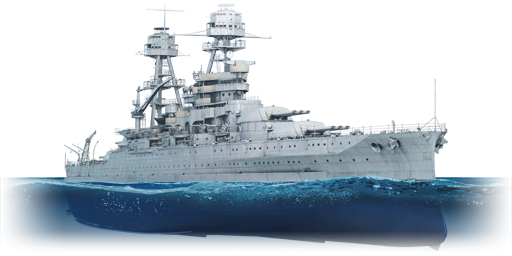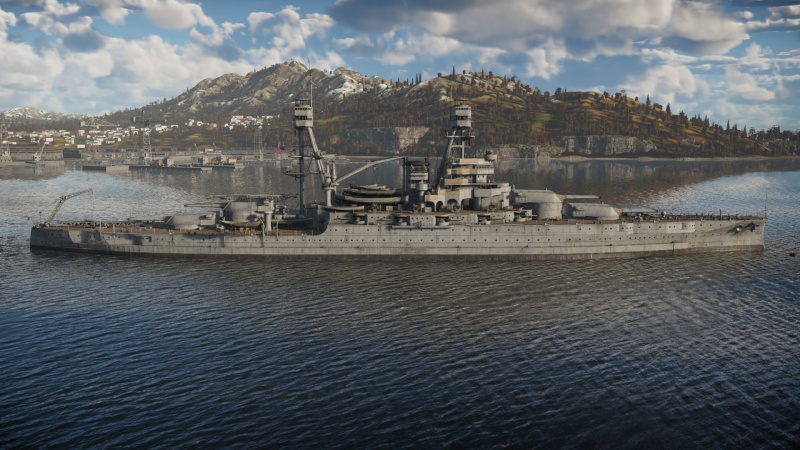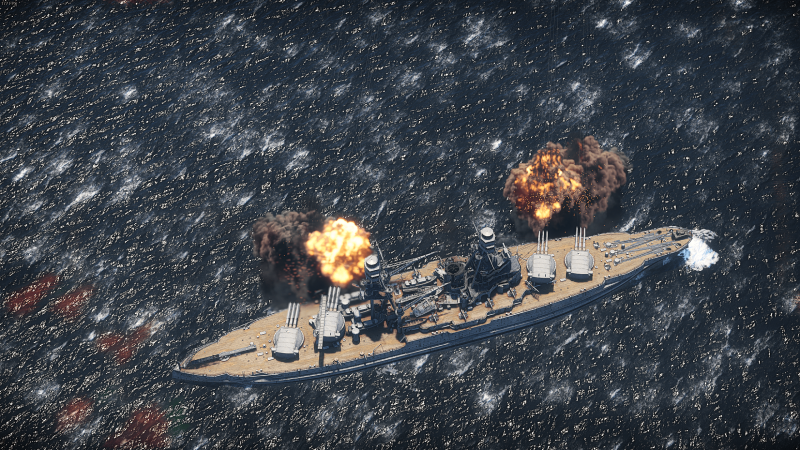USS Arizona
Contents
Description
The Pennsylvania-class, USS Arizona (BB-39), 1938 is a rank VI American battleship with a battle rating of 7.0 (AB/RB/SB). It was introduced in Update "Wind of Change".
General info
Survivability and armour
The USS Arizona, like other American Standard-type battleships, is a very well-armoured battleship. Like other American battleships, she was designed to be able to resist her own 14-inch guns at expected battle ranges. This gives her a main armour belt of 13.5 inches, one of the thickest in-game. The only ship with a thicker main belt currently is SMS Bayern with a thickness of 13.77 inches. Keep in mind that "expected battle ranges" as designed were in excess of 9 km, but captains of USS Arizona can expect much shorter range engagements on the seas of War Thunder regularly. The belt gets progressively thinner the further underwater it is, from 13.5 inches above the waterline, to 8 inches a little under the waterline and then 3 inches well below the waterline.
USS Arizona is in her 1938 refit and therefore has underwater torpedo bulges which can defeat warheads of up to 250 kg TNT equivalent. This will totally defeat American torpedoes such as the Mk.15 and soften the blow from heavier torpedoes such as the G7a, but hits from the Japanese Type 93 torpedo will usually instantly result in either critical damage or a lost ship.
The turrets are the most well-armoured turrets in the game, with angled 18-inch plates on the turret faces, 9 inches on the sides and 13 inches on the barbettes. That being said, the turret roofs only have a relatively thin 5 inches of armour, which could be vulnerable to plunging fire at long range, especially from ships with powerful SAP shells such as SMS Bayern or HMS Hood. The conning tower has 16 inches of armour and even the lower part of the smoke funnel has 15 inches at its thickest point. The citadel has two layers of armour for its roof, one of 4.25 inches and another inch beneath the main citadel roof armour. The fore and aft bulkheads on the vessel are both 13 inches when above the waterline and 8 inches beneath.
USS Arizona is the first ship in War Thunder to use the "all or nothing" armour scheme. This armour philosophy brings the maximum armour to bear where it is needed, for example, the citadel. This is perfect for fighting enemy capital ships at range, as AP shells will pass through areas without armour without fusing, and allows for thicker armour over vital sections of the ship. However, keep in mind that this also makes the unprotected areas of the ship vulnerable to taking damage from smaller ships. These components may not be vital, but some crew still resides in these areas and constant repairing will still bleed the Arizona of crew.
The magazines are also positioned somewhat poorly and are located just below the waterline and against the exterior of the hull. This means that Arizona can be quite prone to ammo rack detonation compared to other battleships. This is especially true for torpedoes that exceed the protection of USS Arizona's 250 kg of torpedo protection. Be aware of any torpedoes, and if unavoidable, attempt to "eat" the torpedo amidships instead of under the turrets.
| Armour | Front | Side | Rear | Deck/Roof |
|---|---|---|---|---|
| Turret | 457.2 mm | 254 mm (Front half) 228.6 mm (Rear half) |
228.6 mm | 127 mm |
| Barbette | 330 mm | |||
| Citadel | 330 mm (Upper) 203 mm (Lower) |
343 mm (Upper) 203 mm (Lower) |
330 mm (Upper) 203 mm (Lower) |
107.95 mm (Upper) 25.4 mm (Lower) |
| Bridge | 406 mm | |||
Both the forward and aft magazines are located inside the large, expansive citadel.
Mobility
The USS Arizona is part of the American Standard-type of battleship. One of the design specifications for every Standard battleship was similar turning circles and a specified maximum speed of 21.0 kn. This, of course, was slightly reduced over time as Arizona underwent refits and gained extra displacement. In her 1938 refit, captains of USS Arizona can expect to reach 20.7 kn, which is typical for a battleship of her era. Battlecruisers such as HMS Hood or Scharnhorst will be quite a bit faster, but most battleships will roughly match the Arizona's pace. Captains of Arizona should not expect to make it to the capture point regularly, and will need to rely on the floatplane if speed is required. As for the turning circle, the Arizona will perform similarly to the preceding USS Wyoming, with a relatively quick response to the rudder but poor sustained turn. Arizona also has a tendency to reverse its turn slightly when the rudder is released, so small inputs may be necessary to keep the bow on course.
| Mobility Characteristics | |||
|---|---|---|---|
| Game Mode | Upgrade Status | Maximum Speed (km/h) | |
| Forward | Reverse | ||
| AB | |||
| Upgraded | 45 | 25 | |
| RB/SB | |||
| Upgraded | 38 | 22 | |
Modifications and economy
Armament
Primary armament
The USS Arizona has 12 x 14-inch main cannons, split into 4 x triple mounts, two fore, two aft. The turrets are extremely slow, with a maximum traverse rate of 2°/second. This is tied with HMS Hood and HMS Marlborough for slowest traverse. The Pennsylvania class was one of the US Navy's earlier forays into triple turrets, and the 14-inch guns were placed too close together. This complicated loading and led to longer than preferable loading times, along with issues with accuracy that led to changes to the timing of the firing of the guns. In War Thunder this gives the USS Arizona a maximum reload time of 40 seconds with an Ace crew. This is 10 seconds longer than the preceding USS Wyoming and 20 seconds longer than ships such as the Scharnhorst or Kronshtadt. This does come with an appreciable increase in firepower over the 12-inch armed battleships previously in the American tree, but it is definitely a weak point compared to other nation's high ranking vessels.
Arizona has access to two shell types: the 14-inch Mk.9 HE shell, and the 14-inch Mk. 8 APCBC. The Arizona gets no access to any other types of shells, and notably is missing SAP shells.
The filler of the Mk.9 HE, at 46.67 kg TNT equivalent is the best currently in the American tech tree, with 13 kg more explosive mass than Wyomings 12-inch HE. It will cause flooding and fire on any lightly armoured ships which take hits, especially considering that the Arizona has a 12 gun broadside, the damage will often be severe enough from a concentrated salvo for many smaller destroyers and sometimes even some light cruisers to commonly roll over and capsize after a hit from Arizona. Bear in mind however that American ammo has historically contained less filler than other nations navies, and this can be seen in War Thunder as well. While containing more filler than the Japanese and German 12-inch-armed battleships, it does not compare favorably even against the 12-inch armed Parizhskaya kommuna, let alone against the monstrous 88.11 kg explosive mass found on the 13.5-inch shells of the HMS Marlborough. As compared to the other battleships in the American tree however, Arizona still comes out the clear victor.
The AP has impressive penetration with 637 mm at 1 km and 444 mm at 10 km, and the filler is up roughly 4 kg from the 12-inch AP shells. This will be the main shell when engaging enemy capital ships, and especially enemy battleships. With high penetration and decent filler, few battleships on the seas of War Thunder can take concentrated hits from USS Arizona unscathed. It is recommended to aim for magazines, engines, shell rooms and other essential components of the enemy ships. Magazine hits in particular should be the goal for captains of Arizona, as while the filler is certainly higher than the 12-inch AP shells, it still will not reliably dispatch large amounts of crew in the same way that SAP shells may. This shell is not suited for firing upon lightly armored ships, as it has such high penetration that it will more often than not fly through the entire ship and explode in the open air, instead of inside the enemy ship as intended. Anything smaller than a heavy cruiser will most likely be effectively dealt with using the Mk.9 HE instead.
| Penetration statistics | |||||||
|---|---|---|---|---|---|---|---|
| Ammunition | Type of warhead |
Penetration @ 0° Angle of Attack (mm) | |||||
| 1,000 m | 2,500 m | 5,000 m | 7,500 m | 10,000 m | 15,000 m | ||
| 14 inch Mk.9 HE | HE | 71 | 71 | 71 | 71 | 71 | 71 |
| 14 inch Mk.8 APCBC | APCBC | 637 | 597 | 536 | 484 | 439 | 372 |
| Shell details | |||||||||
|---|---|---|---|---|---|---|---|---|---|
| Ammunition | Type of warhead |
Velocity (m/s) |
Projectile mass (kg) |
Fuse delay (s) |
Fuse sensitivity (mm) |
Explosive mass (TNT equivalent) (kg) |
Ricochet | ||
| 0% | 50% | 100% | |||||||
| 14 inch Mk.9 HE | HE | 823 | 635 | 0 | 0.1 | 46.67 | 79° | 80° | 81° |
| 14 inch Mk.8 APCBC | APCBC | 823 | 635 | 0.035 | 17 | 15.24 | 48° | 63° | 71° |
Secondary armament
Some ships are fitted with weapons of various calibres. Secondary armaments are defined as weapons chosen with the control Select secondary weapon. Evaluate the secondary armaments and give advice on how to use them. Describe the ammunition available for the secondary armament. Provide recommendations on how to use them and which ammunition to choose. Remember that any anti-air armament, even heavy calibre weapons, belong in the next section. If there is no secondary armament, remove this section.
| Penetration statistics | |||||||
|---|---|---|---|---|---|---|---|
| Ammunition | Type of warhead |
Penetration @ 0° Angle of Attack (mm) | |||||
| 1,000 m | 2,500 m | 5,000 m | 7,500 m | 10,000 m | 15,000 m | ||
| 5-inch Mk.15 common | Common | 114 | 94 | 68 | 50 | 38 | 26 |
| 5-inch APC | APC | 191 | 157 | 115 | 84 | 64 | 44 |
| Shell details | |||||||||
|---|---|---|---|---|---|---|---|---|---|
| Ammunition | Type of warhead |
Velocity (m/s) |
Projectile mass (kg) |
Fuse delay |
Fuse sensitivity (mm) |
Explosive mass (TNT equivalent) (g) |
Ricochet | ||
| 0% | 50% | 100% | |||||||
| 5-inch Mk.15 common | Common | 960 | 22.68 | 0.005 s | 6 | 780 | 47° | 60° | 65° |
| 5-inch APC | APC | 960 | 22.68 | 4 m | 7 | 770 | 48° | 63° | 71° |
Anti-aircraft armament
USS Arizona's AA defence consists of a battery of 8 x 5 inch/25 guns firing HE-TF shells and 8 x 12.7 mm AN/M2 machine guns. The 5 inch battery will be the main defense for the ship, as the machine guns have such a short effective range that the enemy aircraft will most likely have already dropped its ordnance before they begin firing at it. As the Arizona is in a pre-war refit, she does not have access to the highly effective HE-VT shells that made an appearance during WW2. The HE-TF shells can still be effective, but are highly reliant on the crew setting the proper fuse distance on the shells. It is recommended to research the "Anti-air Armament Traverse" modification to improve the speed at which your anti-aircraft can get on target, and increase the crew level of your "AAA calibre reload speed", "AAA gunner accuracy", and "Distance fuse set accuracy" to gain the best results. Captains of the USS Arizona should not expect to swat planes out of the sky like in other ships such as the USS Alaska with its fearsome AA battery, but with these modules and crew upgrades unlocked most aircraft that spend too long near Arizona will be damaged if not destroyed.
Scout plane
Usage in battles
The USS Arizona plays similar to most other battleships that are currently in-game, with one major caveat: the reload time. It is substantially longer at 1.5 rounds per minute compared to the average for battleships of around 2 RPM without an increase of firepower over other Battleships. Even with an ace crew, the crew will still take 40 seconds to reload the main guns. So while sailing out the USS Arizona, be conscious of the reload state and maintain a higher than usual awareness of threats. Ships with a fast reload such as Parizhskaya kommuna, SMS Bayern, and especially ships such as Kronshtadt, USS Alaska and Scharnhorst should be priority targets for captains of the Arizona. All will easily beat the reload rate of USS Arizona, and the last three of the ships mentioned all at least have double the firing rate, and will quickly deal damage if the captain of USS Arizona is unprepared to deal with the situation.
For dealing with smaller targets, binding the "ranging shot" control helps immensely, allowing you to fire one turret at a time instead of firing an entire salvo at a singular target. HE is recommended for lightly armored targets ranging from DDs to CLs, as AP will simply over-penetrate and do little to no damage. The HE can cause holes and massive flooding on lightly armored ships and can help to more easily dispatch of enemy vessels. Arizona certainly does the most damage out of any of the American battleships if the shots land, but will be held back with the lack of SAP shells and fire-rate. The speed of the ship is average compared to other battleships of the Dreadnought era at 21 knots, but on maps with capture zones, she will struggle to make it to capture points before the game is decided most of the time, therefore the floatplane can be utilized to capture objectives once unlocked, as it can make or break a match.
The strategy of sitting close to still for more stable shots like in other battleships is still good for dealing precise blows to the enemy, but torpedoes are still a large threat, as your bulges cannot reliably deal with high-end torpedoes such as the Type 93 Long Lance, which can sink the whole ship with a single torpedo depending on where it strikes. Simply reducing speed is preferred, as it's still relatively stable while not being a sitting duck.
Pros and cons
Pros:
- Heavy armour over the most critical modules
- Torpedo bulges
Cons:
- Inadequate AA
- Most of the auxiliary cannons are unprotected
- Extremely slow (low top speed, low acceleration, slow turret traverse speed)
- Extremely long reload for the main cannons
- Poor quality main calibre shells; Low damage output
History
Devblog
After the design of the preceding Nevada-class battleships that employed the novel "all or nothing" armour scheme, the Navy sought a slightly larger, improved design to be ordered for construction in the fiscal year of 1913. As such, the Bureau for Construction & Repair came up with a number of design sketches to satisfy the Navy's requirement.
In April 1912, the final design of what was to become the Pennsylvania class was chosen with further work on refining the design continuing until September. The decision to order the design into construction was met with some political opposition over concerns that the design was too weak and expensive. Nonetheless, the class was approved for construction, with USS Pennsylvania being ordered in August 1912 while its sistership USS Arizona followed suit in March 1913.
USS Arizona was laid down in March 1914, launched in June 1915 and commissioned in October 1916. Due to oil shortages in Europe at the time, the ship didn't take part in hostilities during WWI, but instead escorted the American president Woodrow Wilson on his trip to Brest for the Paris Peace Conference in 1919 along with other warships. Subsequently, both Arizona and its sistership were transferred to the Pacific Fleet, undergoing substantial modernization in 1929 through 1931.
Throughout the 1930s, both ships took part in regular fleet exercises. However, during the Attack on Pearl Harbor in December 1941, USS Arizona was sunk following a catastrophic explosion of her fore magazines, after an aerial bomb managed to penetrate the ship's deck.
Media
- Skins
- Videos
See also
Links to articles on the War Thunder Wiki that you think will be useful for the reader, for example:
- reference to the series of the ship;
- links to approximate analogues of other nations and research trees.
External links
| Brooklyn Navy Yard | |
|---|---|
| Cruiser, Light (CL) | |
| Brooklyn-class | USS Brooklyn · USS Helena |
| Heavy Cruisers (CA) | |
| Pensacola-class | USS Pensacola |
| Battleships (BB) | |
| Pennsylvania-class | USS Arizona |
| USA battleships | |
|---|---|
| Delaware-class | USS North Dakota |
| Wyoming-class | USS Wyoming · USS Arkansas |
| New York-class | USS Texas |
| Nevada-class | USS Nevada |
| Pennsylvania-class | USS Arizona |
| New Mexico-class | USS Mississippi |
| Tennessee-class | USS Tennessee |






